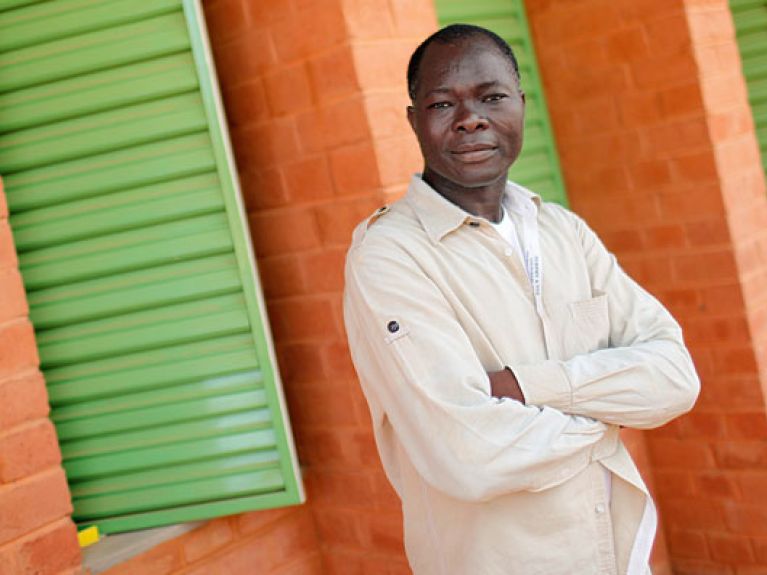Wanderer between two worlds
African-German architect Francis Kéré combines Western engineering expertise with an African gift for improvisation.

The story of Diébédo Francis Kéré sounds a little like a fairy tale. The chief’s son from Gando in Burkina Faso was the first child from his village who was allowed to go to school. After completing his school examinations he received a scholarship from the German Development Service to train as a carpenter. Instead of returning to Africa after the course, however, he studied architecture at Technische Universität Berlin. Because the traditional earthen structures of his African home suffered considerable damage during the rainy season he came up with the idea of adding cement to make them more durable. While he was still a student, he organized the construction of a primary school in Gando and taught the villagers this new building method. In a communal joint effort, they built houses, a library and a women’s centre. Today Kéré has an architect’s office in Berlin, is in demand as a lecturer and advises projects not only in Africa, but also in Germany, the UK, Switzerland and even China.
Of course, his career has not been quite so easy. Initially, Kéré had to overcome considerable resistance, also in his native country. When he began work in Gando, people there wanted a Western-style building and protested against the supposedly unsuitable earthen building material. “Construction in Africa involves continuous dialogue with all possible partners, mainly the users of the building. If communication doesn’t take place, people are not convinced of the building and will not maintain it later. As an architect you need lots of patience,” explains Kéré. In addition to working as a mediator and organizer, inventiveness is also required – and the courage to try out unusual solutions.
As a child Kéré had to sit in a much too small classroom with ambient temperatures of over 40 degrees Celsius. That’s why he later developed a double roof system with slatted windows for the school in Gando. The air circulates naturally – and as a result provides a pleasant climate. This technology, which has now been used in many other locations, does not depend on a functioning electricity supply and difficult-to-procure spare parts.
The idea of building on sustainable infrastructure was what Kéré also contributed to the project for which he is best known in Germany: Christoph Schlingensief’s Opera Village. The director, who died in 2010, originally envisaged an African festival theatre that was to become the catalyst for global developments in culture, politics and sustainability. Kéré persuaded Schlingensief that the Opera Village had to offer benefits for the people in the surrounding area. In the meantime there is a school, living quarters for teachers and a sports ground. The solutions are simple, but that is not what matters. It is more important that everything is built together as a joint communal effort.
For several years now, the Opera Village has been growing in the middle of the savannah, 30 kilometres northeast of the Burkinan capital Ouagadougou. Kéré has planned it as a spiral-shaped kraal following the pattern of a traditional African village. Speaking about the current state of development in February this year, he reported: “Some 160 children are already learning in the school. The infirmary will soon be opened. The only thing that is still missing is the festival theatre in the centre, which will be an earthen structure with gumwood cladding and resemble a tent. At the present time, however, the foundation doesn’t yet have the money to start the last element of our Opera Village.”
Outside Africa, the young Kéré Architecture team in Germany is currently working on the renewal of the site of the former Taylor Barracks in Mannheim. Until the withdrawal of the US troops this was a restricted military zone, which is separated from an area of woods by a highway. The development plan envisages the end of this division and making the area accessible again via a green bridge and a grass verge with an artificial lake. According to the latest plans, there will also be space for a business zone and a media park. The first users are already scheduled to move in at the end of 2015.
If you ask Francis Kéré about the difference between building in Africa and Europe, his answer is Solomon-like: “I don’t have a specific aesthetic principle in mind, but orient myself towards the needs of the users and the local circumstances. That gives rise to a harmonious entity that is adapted to local conditions.”
Despite his serious preference for sustainable construction and natural materials, Kéré has not lost his sense of humour. One of his installations, a temporary pavilion made of plastic, is on display at the prestigious Royal Academy of Arts in London until 6 April 2014: “I consider plastic typical of London. England was the first industrial nation ever. Plastic is everywhere, but as a rule it is hidden. I move it into the centre. My cave-like designs invite the public to contribute.”
And it’s true: in the meantime hundreds of visitors have placed straws in the gaps in his installation. This result at least is typical for Kéré: it is a growing organism created by a large number of people. ▪
Judith Leister

